Trump, Biden, the story of two completely opposite campaigns
Published : 03 Nov 2020, 02:27
A sea of red baseball caps awaits Donald Trump on the airport tarmac, a symphony of carhorns sounds at a parking lot for Joe Biden. The scenario is part of the message in the run-up to the Nov. 3 election, and the candidates' rallies tell the story of the two diametrically opposed campaigns.
The president has followed his script from 2016, ignoring the precautions linked to the coronavirus pandemic and allowing himself to be adulated by huge crowds at more than 50 campaign rallies since June. His Democratic rival has adhered to the health recommendations of the experts, scheduling markedly fewer events and avoiding attracting large crowds.
That contrast has marked the dynamics of an unprecedented campaign during which Trump has mocked Biden for "not coming out of the basement" of his house while Biden has accused the president of being irresponsible, for scheduling rallies where the crowd is "as jammed together as possible, putting them at risk" of becoming infected by potential Covid-19 carriers in the throng.
After three months cooped up in the White House and heavily criticized for his management of the pandemic, in June Trump got back on what he thinks is more secure ground: standing at the podium at rallies where thousands of people shout that they want "four more years" with him as president.
Perhaps because his first attempt to draw a huge crowd was something of a bust in what proved to be a semi-empty stadium in Oklahoma, Trump's campaign quickly identified a venue that would not disappoint the president: airport tarmacs all across the country.
Since then, Air Force One has been the backdrop in every key state while Trump has addressed the crowd, even joking that he loves the new format because he can arrive and leave the rally sites without interacting too much with his supporters.
Not even Covid-19 could quash the president's apparent addiction to the spotlight and he only put things on hold for 12 days when he became infected with the virus.
"I feel so powerful," declared Trump upon returning to the campaign trail in mid-October in Florida, where thousands of people waited to welcome him, hardly any of them wearing facemasks, the use of which is not obligatory at the president's rallies.
The president's hectic agenda is practically identical to the one he pursued in 2016 right up to his very last rally on the Monday before the election in Grand Rapids, Michigan, the same spot where he ended his campaign four years ago.
At every event, Trump has tried to resurrect the magic of his first campaign, which landed him in the Oval Office against all the forecasts. And despite having spent four years in the White House, he continues to present himself as an insurgent who is breaking norms, as he profiles Biden as part of the political "swamp" he says exists in Washington.
Last Friday in Wisconsin, Trump claimed that he's not a politician and doesn't always follow Washington's rules.
That message lights a fire under his most faithful followers, but it's not clear whether it will be enough to convince the other voters he needs to achieve reelection. His rallies could even "hurt him," according to Mark Peterson, a professor of politics at the University of California at Los Angeles (UCLA).
Voters are not unconditional Trump backers, Peterson said, especially the ones he most needs such as suburban women, and they see a president disconnected from reality, violating the directives of his own administration and acting in an irresponsible manner.
Biden's team is confident as the campaign wraps up and his strategy has been designed to illustrate his message that Trump has been imprudent in his handling of the pandemic - which has killed some 230,000 Americans - while the former vice president says he would be guided by science in determining how to manage the pandemic if he's elected.
Biden delayed much more than Trump in resuming in-person campaign events amid the pandemic and it wasn't until September that he began to schedule regular rallies, his first ones being staged for relatively few people asked to socially distance by standing in circles painted on the ground.
Later, he decided to imitate the format of the classic drive-in and schedule rallies at which attendees could arrive in their vehicles, park and remain inside and listen via the radio or through the open windows to remarks delivered by Biden and his running mate, Sen. Kamala Harris, or former President Barack Obama.
Applause lines were responded to with horn honking and Trump didn't delay in mocking the new system, saying he didn't understand the format and claiming that only a few people were showing up at Biden's rallies.
Biden's campaign isn't worried by the president's criticism, but some Democrats have been unsettled thinking that the contrast with Trump could strengthen the idea that their candidate lacks energy for often the president has held several rallies a day while the public agenda of the former VP has been empty.
Ahead in the voter surveys for months now, Biden has opted to travel sporadically to key states like Pennsylvania and Michigan, sending Harris to others farther afield like Arizona and Texas, and letting Trump exhaust himself in his continuous rallies, which are not receiving as much media coverage as they did in 2016.
The more Trump talks, the more votes he loses, Democratic strategist Chris Kofinis told NBC News last week, adding that he's going to be the first president who loses his job by talking.
Trump's campaign chairman, Bill Stepien, at an October press conference said that at least the president is speaking directly to thousands of voters, while Biden is spending much of his campaign war chest on "television ads."


